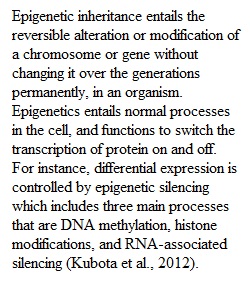


Q Choose one of the prompts. Contrast asexual with sexual reproduction and give an example of an organism for each type of reproduction. Be sure to include these words in your description: mitosis and meiosis, haploid and diploid, genetic diversity, clone. NOTE: Diploid is defined as two sets of chromosomes - full set. Cells with a nucleus and centrosomes start mitosis or meiosis with diploid chromosomes. Gametes are haploid - half a set of chromosomes. (eggs, sperms, pollen, many types of spores) Prokaryotes are haploid and use binary fission not mitosis. OR Epigenetics inheritance is the inheritance of gene expression that is NOT due to the changes of the sequencing of the bases on the DNA. Watch the video above. Why is epigenetic inheritance like a ghost in your genes? EpigeneticsLinks to an external site. Rubric Connections (3) Connections (3) Criteria Ratings Pts This criterion is linked to a Learning OutcomeAccuracy - scientifically valid 5 pts Full Marks 2 pts some inaccuracies 0 pts many inaccuracies 5 pts This criterion is linked to a Learning OutcomeComplete Answer All aspects of question are answered. 5 pts Full Marks 3 pts somewhat incomplete 0 pts incomplete 5 pts This criterion is linked to a Learning OutcomeDescriptive - clear and concise 5 pts Full Marks 3 pts confusing 0 pts unclear 5 pts Total Points: 15 PreviousNext
View Related Questions